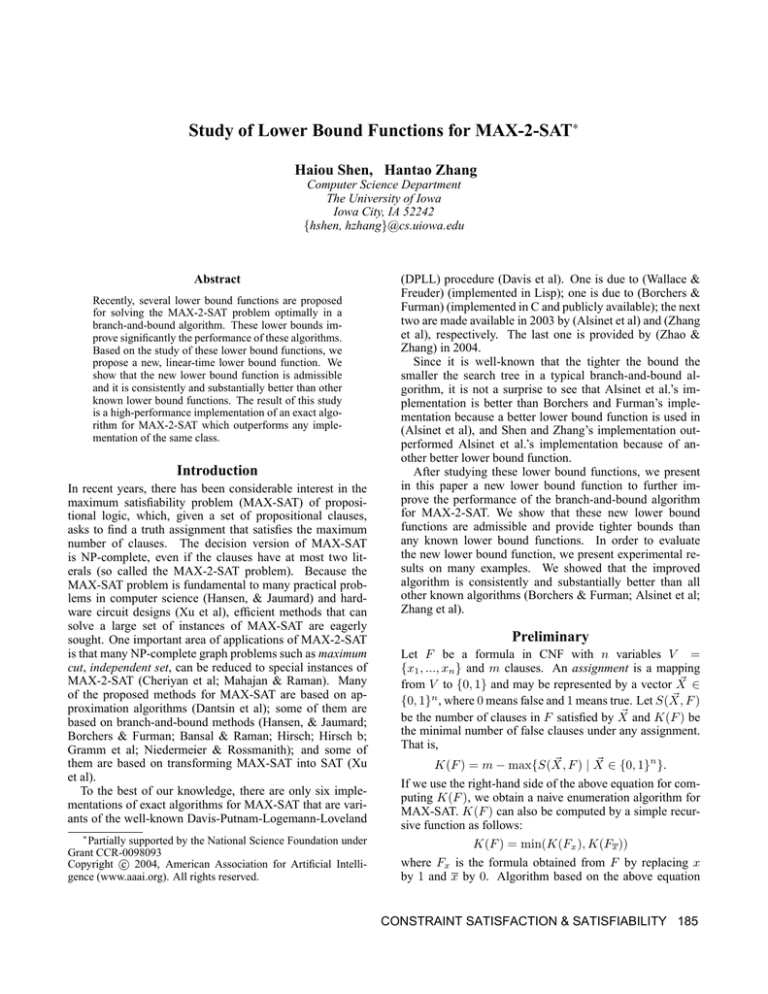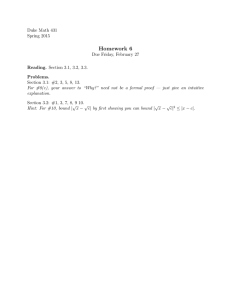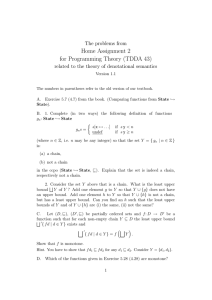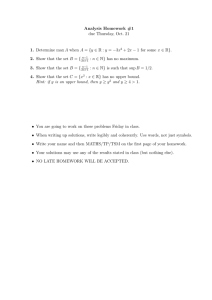
Study of Lower Bound Functions for MAX-2-SAT∗
Haiou Shen, Hantao Zhang
Computer Science Department
The University of Iowa
Iowa City, IA 52242
{hshen, hzhang}@cs.uiowa.edu
Abstract
Recently, several lower bound functions are proposed
for solving the MAX-2-SAT problem optimally in a
branch-and-bound algorithm. These lower bounds improve significantly the performance of these algorithms.
Based on the study of these lower bound functions, we
propose a new, linear-time lower bound function. We
show that the new lower bound function is admissible
and it is consistently and substantially better than other
known lower bound functions. The result of this study
is a high-performance implementation of an exact algorithm for MAX-2-SAT which outperforms any implementation of the same class.
Introduction
In recent years, there has been considerable interest in the
maximum satisfiability problem (MAX-SAT) of propositional logic, which, given a set of propositional clauses,
asks to find a truth assignment that satisfies the maximum
number of clauses. The decision version of MAX-SAT
is NP-complete, even if the clauses have at most two literals (so called the MAX-2-SAT problem). Because the
MAX-SAT problem is fundamental to many practical problems in computer science (Hansen, & Jaumard) and hardware circuit designs (Xu et al), efficient methods that can
solve a large set of instances of MAX-SAT are eagerly
sought. One important area of applications of MAX-2-SAT
is that many NP-complete graph problems such as maximum
cut, independent set, can be reduced to special instances of
MAX-2-SAT (Cheriyan et al; Mahajan & Raman). Many
of the proposed methods for MAX-SAT are based on approximation algorithms (Dantsin et al); some of them are
based on branch-and-bound methods (Hansen, & Jaumard;
Borchers & Furman; Bansal & Raman; Hirsch; Hirsch b;
Gramm et al; Niedermeier & Rossmanith); and some of
them are based on transforming MAX-SAT into SAT (Xu
et al).
To the best of our knowledge, there are only six implementations of exact algorithms for MAX-SAT that are variants of the well-known Davis-Putnam-Logemann-Loveland
∗
Partially supported by the National Science Foundation under
Grant CCR-0098093
c 2004, American Association for Artificial IntelliCopyright gence (www.aaai.org). All rights reserved.
(DPLL) procedure (Davis et al). One is due to (Wallace &
Freuder) (implemented in Lisp); one is due to (Borchers &
Furman) (implemented in C and publicly available); the next
two are made available in 2003 by (Alsinet et al) and (Zhang
et al), respectively. The last one is provided by (Zhao &
Zhang) in 2004.
Since it is well-known that the tighter the bound the
smaller the search tree in a typical branch-and-bound algorithm, it is not a surprise to see that Alsinet et al.’s implementation is better than Borchers and Furman’s implementation because a better lower bound function is used in
(Alsinet et al), and Shen and Zhang’s implementation outperformed Alsinet et al.’s implementation because of another better lower bound function.
After studying these lower bound functions, we present
in this paper a new lower bound function to further improve the performance of the branch-and-bound algorithm
for MAX-2-SAT. We show that these new lower bound
functions are admissible and provide tighter bounds than
any known lower bound functions. In order to evaluate
the new lower bound function, we present experimental results on many examples. We showed that the improved
algorithm is consistently and substantially better than all
other known algorithms (Borchers & Furman; Alsinet et al;
Zhang et al).
Preliminary
Let F be a formula in CNF with n variables V =
{x1 , ..., xn } and m clauses. An assignment is a mapping
~ ∈
from V to {0, 1} and may be represented by a vector X
n
~
{0, 1} , where 0 means false and 1 means true. Let S(X, F )
~ and K(F ) be
be the number of clauses in F satisfied by X
the minimal number of false clauses under any assignment.
That is,
~ F) | X
~ ∈ {0, 1}n }.
K(F ) = m − max{S(X,
If we use the right-hand side of the above equation for computing K(F ), we obtain a naive enumeration algorithm for
MAX-SAT. K(F ) can also be computed by a simple recursive function as follows:
K(F ) = min(K(Fx ), K(Fx ))
where Fx is the formula obtained from F by replacing x
by 1 and x by 0. Algorithm based on the above equation
CONSTRAINT SATISFACTION & SATISFIABILITY 185
is also called Davis-Putanm-Logemann-Loveland procedure
(Davis et al).
To speed up the computation, a lower bound is often introduced and the algorithm is called branch-and-bound algorithm. This paper introduces a new lower bound to improve the performance of the algorithm. To facilitate the
discussion, we borrow some convention and the algorithm
presented in (Zhang et al).
For every literal x, we use variable(x) to denote the variable appearing in x. That is, variable(x) = x for positive
literal x and variable(x) = x for negative literal x. If y is a
literal, we use y to denote x if y = x.
A partial (complete) assignment can be represented by a
set of literals (or unit clauses) in which each variable appears
at most (exactly) once and each literal is meant to be true in
the assignment. If variable(x) does not appear in a partial
assignment A, then we say literals x and x are unassigned in
A. For an unassigned literal x, µ(x) is the number of the unit
clause for literal x in the current clause set, including those
generated during the search. Initially, µ(x) is the number of
unit clauses for literal x in the input.
The algorithm taken from (Zhang et al) is presented in
Figure 1. In the algorithm, B(x) = {y | (x ∨ y) ∈
F, variable(x) < variable(y)} for each literal x. By abuse
of notations, we assume xi is represented by i and xi is represented by i, where 1 ≤ i ≤ n. Hence, we have µ(i) =
µ(xi ), B(i) = B(xi ), µ(i) = µ(xi ) and B(i) = B(xi )..
The following result is provided in (Zhang et al).
Theorem 1 Suppose F0 is a set of binary clauses of n variables. Then max 2 sat(F0 , n) will return the minimum number of false clauses under any assignment. The time complexity of max 2 sat(F0 , n) is O(n2n ) and the space complexity is L/2 + O(n), where L is the size of the input.
Lower Bounds
Since the algorithm is trying to find the minimum number
of false clauses under any assignment, lower bounds which
estimate the minimum number of false clauses at a given
search node are useful for cutting out some search space.
In line 3 of bb max 2 sat in Figure 1, popular lower bound
functions can be used to improve its performance. We may
also compute upper bound functions to cut off some search
space. In practice, we all adopted the two-phase approach
used by Borchers and Furman by first calling a local search
algorithm for computing an upper bound before the search
starts. We found that this approach is much more effective
than computing an upper bound in each internal node of the
search tree.
However, for lower bounds, we have not found such an
effective function which can be computed before the search.
Many algorithms from linear programming can be used for
computing lower bounds. However, since this lower bound
function is called in every internal node of the search tree, it
must be very efficient. In fact, the lower bounds proposed in
(Alsinet et al), (Shen & Zhang), and our new lower bound
function take only linear-time (in terms of the input size).
The following three lower bound functions are used in
(Borchers & Furman; Alsinet et al; Shen & Zhang 2004):
186
CONSTRAINT SATISFACTION & SATISFIABILITY
Figure 1: An exact algorithm for MAX-2-SAT.
function max 2 sat ( F0 : clause set, n: integer)
// initiation
min fcl := MAX INT;
for i := 1 to n do
compute B(i) and B(i) from F0 ;
// assuming no unit clauses in F0
µ(i) := µ(i) := 0;
end for
bb max 2 sat(1, n, 0);
return min fcl;
end function
function bb max 2 sat( i, n: integer, k: integer )
1
if (i > n) // end of the search tree
2
if (k < min fcl) min fcl := k;
3
else if (lower bound(i) + k < min fcl)
4
if (µ(i) + k < min fcl) ∧ (µ(i) < µ(i) + |B(i)|)
5
record unit clauses(xi );
6
bb max 2 sat(i + 1, n, k + µ(i));
7
undo record unit clauses(xi );
8
end if
9
if (µ(i) + k < min fcl) ∧ (µ(i) ≤ µ(i) + |B(i)|)
10
record unit clauses(xi );
11
bb max 2 sat(i + 1, n, k + µ(i));
12
undo record unit clauses(xi );
13
end if
14 end if
end function
procedure record unit clauses ( x: literal )
for y ∈ B(x) do
µ(y) := µ(y) + 1
end for;
end procedure
procedure undo record unit clauses ( x: literal )
for y ∈ B(x) do
µ(y) := µ(y) − 1
end for;
end procedure
Figure 2: The function for computing LB3.
Figure 3: The function for computing LB4.
function lower bound3 ( i: integer ) return integer
1
LB3 = LB2;
2
for (x ∨ y) in S do
3
if (t(x) > 0) ∧ (t(y) > 0)
4
LB3 = LB3 + 1;
5
t(x) = t(x) − 1; t(y) = t(y) − 1;
6
end for
7
return LB3
end function
function lower bound4 ( i: integer) return integer
1
LB4 = LB1;
2
while (i ≤ n) do
3
LB4 = LB4 + min(µ(i), µ(i));
4
t = |µ(i) − µ(i)|;
5
if µ(i) > µ(i) Y = B(i) else Y = B(i)
6
for y ∈ Y if (t > 0) do
7
t = t − 1;
8
µ(y) = µ(y) + 1;
9
end for
10
i=i+1
11 end while
12 return LB4
end function
• Borchers and Furman’s lower bound:
LB1 = the number of conflicting (or empty) clauses by the
current partial assignment;
• Alsinet, ManyàPand Planes’ lower bound:
n
LB2 = LB1 + j=i min(µ(j), µ(j));
• Shen and Zhang’s lower bound:
LB3 = lower bound3(i).
Here µ(x) is the number of the unit clause for literal
x under the current partial assignment and the function
lower bound3 is provided in Figure 2. Using LB2 instead
LB1 contributes greatly to the improved performance of
Alsinet, Manyà and Planes’ implementation over Borchers
and Furman’s. It is easy to see that LB1 ≤ LB2 ≤ K(F ).
In general, a lower bound LB is said to be admissible if LB
≤ K(F ). In other words, both LB1 and LB2 are admissible.
To compute LB3, for any literal x, let t(x) = µ(x) −
µ(x) and S be the set of clauses of which both literals are
unassigned under the current assignment.
The following theorem is given in (Shen & Zhang 2004):
Theorem 2 LB1 ≤ LB2 ≤ LB3 ≤ K(F ).
To prove the above theorem, we may use the following
lemma:
Lemma 3 If there is a clause x ∨ y in F such that µ(x) <
µ(x) and µ(y) < µ(y), then LB2 + 1 ≤ K(F ).
Proof Given µ(x) > µ(x) and µ(y) > µ(y), for a clause
x ∨ y, if we assign 0 to x, µ(y) will be increased by 1. So
min(µ(y), µ(y)) in LB2 will be increased by 1. If we assign
1 to x, then min(µ(x), µ(x)) in LB2 will be increased because µ(x) > µ(x). In both cases, we can see that it is safe
to increase LB2 by 1. []
A New Lower Bound
We design another lower bound, lower bound4 in Figure 3,
to fully explore the property revealed by Lemma 3.
It is easy to prove the following result.
Lemma 4 The
worst-case P time
complexity
of
n
lower bound4(i) is O((n−i)+ j=i max(|B(j)|, |B(j)|)).
Before we prove formally that LB4 is indeed an admissible lower bound for MAX-2-SAT, let us look at a simple
example.
Example 5 Suppose a 2CNF formula F is represented by µ
and S, where µ(a) = µ(b) = µ(c) = µ(c) = 0, µ(a) =
µ(b) = 1 and S = {a ∨ c, b ∨ c}. It is easy to see K(F ) = 1.
LB3 = 0 because there exists no clause x ∨ y in F such that
µ(x) > µ(x) and µ(y) > µ(y).
Suppose a < b < c, then LB4 = 1 because a ∨ c will
increase µ(c) by 1 and b ∨ c will increase µ(c) by 1, making
min(µ(c), µ(c)) = 1.
Let F (i) be the remaining nontrivial (neither empty nor
tautology) clauses when bb max 2 sat(i, n, k) in Figure 1
is called. Recall that for any unassigned literal x, µ(x)
is the number of the unit clause x and k in the procedure
bb max 2 sat(i, n, k) is the number of empty clauses created by the partial assignment on variables x1 to xi−1 . Let
u(x) be the multiset of µ(x) copies of the unit clause x and
xB(x) denote the set {(x ∨ y) | y ∈ B(x)}. Then we have
F (i) = u(xi ) ∪ u(xi ) ∪ xi B(i) ∪ xi B(i) ∪ F (i + 1)
where F (i + 1) is the subset of F (i) not containing the variable xi (assuming F (n + 1) = ∅).
Let F be F (i) and x be xi in
K(F ) = min(K(Fx ), K(Fx ))
we have
K(F (i)xi ) = µ(i) + K(B(i) ∪ F (i + 1))
K(F (i)xi ) = µ(i) + K(B(i) ∪ F (i + 1))
K(F (i))
= min(K(F (i)xi ), K(F (i)xi ))
(1)
(2)
(3)
Since K(F (i + 1)) ≤ K(Y ∪ F (i + 1)) for any clause
set Y , we have min(µ(i), µ(i)) + K(F (i + 1)) ≤ K(F (i)),
by discarding B(i) and B(i) from (1) and (2), respectively.
This relation shows why LB2 is an admissible lower bound.
To show that LB4 is admissible, we need the following
lemma.
Lemma 6 For any subset X ⊆ B(i), if |X| ≤ µ(i) − µ(i),
then
min(µ(i), µ(i)) + K(X ∪ F (i + 1)) ≤ K(F (i))
(4)
CONSTRAINT SATISFACTION & SATISFIABILITY 187
Proof If |X| = 0, then (4) is trivially true. If |X| > 0, then
µ(i) > µ(i) and (4) becomes
µ(i) + K(X ∪ F (i + 1)) ≤ K(F (i))
(5)
According to (3), there are two cases:
Case 1: K(F (i)xi ) < K(F (i)xi ). So K(F (i)) =
K(F (i)xi ) = µ(i) + K(B(i) ∪ F (i + 1)) by (1). Because µ(i) ≥ µ(i) + |X| and K(B(i) ∪ F (i + 1)) ≥
K(F (i+1)) ≥ K(X ∪F (i+1))−|X|, we have K(F (i)) ≥
µ(i) + |X| + K(X ∪ F (i + 1)) − |X|, or (5).
Case 2: K(F (i)xi ) ≥ K(F (i)xi ). So K(F (i)) =
K(F (i)xi ) = µ(i) + K(B(i) ∪ F (i + 1)) by (2). Since
X ⊆ B(i), K(B(i) ∪ F (i + 1)) ≥ K(X ∪ F (i + 1)). So
(5) holds. []
A mirror of the above lemma can be obtained by switching xi and xi .
Theorem 7 LB4 ≤ K(F ).
Proof We will use Lemma 6 (or its mirror) at each iteration
of i in lower bound4. If i = n, then LB4 = LB3 = LB2 =
min(µ(i), µ(i)). If i < n, suppose LB40 is the value computed inside lower bound4 for X ∪ F (i + 1), where
Figure 4: The function for computing LB4a.
function lower bound4a ( i: variable) return integer
1
LB4 = LB1;
2
while (i ≤ n) do
3
LB4 = LB4 + min(µ(i), µ(i));
4
t = |µ(i) − µ(i)|;
5
if µ(i) > µ(i) Y = B(i) else Y = B(i)
6
S=∅
7
for j ∈ Y if (t > 0) do
8
if (µ(j) ≥ µ(j)) S = S ∪ {j} else
9
t = t − 1;
10
µ(j) = µ(j) + 1;
11
end for
12
for j ∈ S if (t > 0) do
13
t = t − 1;
14
µ(j) = µ(j) + 1;
15
end for
16
i=i+1
17 end while
18 return LB4
end function
F (i) = u(xi ) ∪ u(xi ) ∪ Xi B(i) ∪ xi B(i) ∪ F (i + 1).
As an inductive hypothesis, we assume
LB40 ≤ K(X ∪ F (i + 1)).
If µ(i) > µ(i) then Y = B(i) and a subset X of Y is added
at lines 6–9, where |X| ≤ t as computed at line 4. Since
LB4 = min(µ(i), µ(i)) + LB40 , by induction hypothesis,
LB4 ≤ min(µ(i), µ(i)) + K(X ∪ F (i + 1)) ≤ K(F (i)).
The case when µ(i) ≤ µ(i) is similar. In both cases,
LB4 ≤ K(F (i)). []
Comparison of LB3 and LB4
In (Shen & Zhang 2004), it has been shown by experimental results that LB3 can improve the performance of MAX2-SAT ten times faster than other lower bounds (LB1 and
LB2). Since LB3 and LB4 have the same worst-case time
complexity, we wish that LB4 is never smaller than LB3,
as Example 5 already showed that LB4 can be greater than
LB3.
Let us look at Example 5 again. We saw that LB4 = 1
when a < b < c. The same result can be obtained when
b < a < c, a < c < b, or b < c < a. However, if c < a < b
(or c < b < a), then LB4 = 0 because neither µ(a) nor µ(b)
can be increased by the two binary clauses.
This simple example shows that the value of LB4 depends
on how the propositional variables are ordered in the implementation. In contrast, the value of LB3 does not depend on
variable ordering. Variable ordering is an important performance issue of the algorithm in Figure 1. Several orderings
have been compared in (Shen & Zhang 2004), including an
ordering based on the implication graph of F .
The next example shows that the ordering for choosing
clauses in the computation of LB3 and LB4 affect their values.
188
CONSTRAINT SATISFACTION & SATISFIABILITY
Example 8 Let F be represented by µ and S, where µ(a) =
µ(b) = µ(c) = µ(d) = 0, µ(a) = µ(b) = µ(c) = µ(d) =
1, and S = {a ∨ b, b ∨ c, c ∨ d}. Obviously, K(F ) = 2.
If b ∨ c is chosen first at line 2 of lower bound3, then LB3
= 1; otherwise, LB3 = 2. Similarly, for computing LB4, if
b ∨ c is chosen first at line 6 of lower bound4, (either b or c
must be the smallest in the variable ordering.) then LB4 =
1; otherwise LB4 = 2.
This example shows that LB3 may be 2 while LB4 may
be 1. Thus LB3 and LB4 are different in general. Now we
have the following question: If the same clause ordering is
used for computing both LB3 and LB4, is it true that LB3 ≤
LB4? The answer is unfortunately no, as illustrated by the
following example.
Example 9 Suppose F is represented by µ and S, where
µ(a) = µ(b) = µ(c) = µ(c) = 0, µ(a) = µ(b) = 1 and
S = {a ∨ c, a ∨ b}. Then K(F ) = 1 and LB3 = 1 because of
a ∨ b. However, if the clauses are chosen in the given order,
then LB4 = 0 because t = 1 for a is used on c when a ∨ c is
chosen.
To avoid the problem illustrated in the above example,
at line 6 of lower bound4, we may prefer those clauses in
Y that will increase the value of LB4. This idea is implemented as function lower bound4a in Figure 4. Those literals in Y that will not increase the value of LB4 immediately
are stored in S ⊆ Y and processed later at lines 13–16.
However, we do not have a proof that LB4 computed by
lower bound4a is always greater than or equal to LB3. To
make sure LB4 ≥ LB3, let us say a clause ordering <c is
LB3-compatible if for any two clauses (a ∨ b) and (c ∨ d),
if (a ∨ b) satisfies (t(a) > 0) ∧ (t(b) > 0) but (c ∨ d) does
not, then (a ∨ b) <c (c ∨ d).
Theorem 10 If we select clauses from Y at line 6 of
lower bound4(i) using a LB3-compatible clause ordering
(from small to big), then LB3 ≤ LB4.
In Example 9, any LB3-compatible ordering will place
a ∨ b before a ∨ c. Using this ordering for computing LB4,
we have LB3 = LB4 = 1.
The only extra cost for using a LB3-compatible clause
ordering in lower bound4 is that we have to execute lines 6–
9 twice: The first time for those y ∈ Y , t(y) > 0, and the
second time for those such that t(y) ≤ 0. In other words,
using this ordering will not compromise the worst-case time
complexity of lower bound4. However, our implementation
of LB4 using a LB3-compatible clause ordering is slightly
slower than lower bound4a, because of this second visit.
Experimental Results
We already implemented the algorithm presented in Figure 1 and the lower bound functions LB2 and LB3 (Shen
& Zhang 2004). The implementation is written in C++ and
the code is available to public. We have also implemented
two lower bounds presented in this paper: lower bound4
and lower bound4a, and they are denoted by LB4 and
LB4a, respectively. Note that the function lower bound(i)
in bb max 2 sat (line 3) of Figure 1 returns a lower bound
value minus LB1 in our experiments.
Table 1 shows the performance of five implementations
on Borchers and Furman’s benchmarks. The six implementations are BF (Borchers & Furman), AMP (Alsinet et al),
ZZ (Zhao & Zhang), LB3 (Shen & Zhang 2004), LB4 and
LB4a. The benchmarks contain randomly generated 2-CNFs
of 50, 100, and 150 variables (#var), and are available from
their web site. It is clear from that the table that LB4a provides the best result while LB3 and LB4 are ranked second.
The harder the problem, the more significant the gain of
LB4a over other implementations.
(Shen & Zhang 2004) have shown that LB3 is about ten
times faster than other implementations on many random 2CNFs. Table 2 provides a detailed comparison of LB3 and
LB4a. The instances are random 2CNF with 100 or 200
variables and various number of clauses. The data show the
average runs on 100 instances (of the same numbers of variables and clauses). It is clear from the table that LB4a explores only 1/4 of the search space (represented by the number of branches in the search tree) of LB3 and LB4a is about
3 times faster than LB3 on average. Note that the number
in the parentheses following the run time is the number of
unfinished cases after two hours of running.
Conclusion
After studying several lower bound functions for the branchand-bound algorithm of MAX-2-SAT, we have proposed a
new lower bound function and proved that it is admissible
and it is indeed a better lower bound function than LB2
and LB3. We have implemented this function and our experimental results showed that the lower bound function is
consistently and substantially better than other lower bound
functions. All the techniques presented in the paper can be
applied to the weighted MAX-2-SAT problem where each
Table 1: Experimental results on Borchers and Furman’s examples. The times (in seconds) are collected on a Pentium
4 linux machine, 2.4GHz, 1G memory; “–” means the job
doesn’t finish in one hour; ∗ means the output was erroneous.
Problem
#fcl
#var #cls
50
100
4
150
8
200
16
250
22
300
32
350
41
400
45
450
63
500
66
100
200
5
300
15
400
29
500
44
600
65
150
300
4
450
22
600
38
BF
AMP
ZZ
LB3
LB4
LB4a
0.02
0.06
4.18
24
350
2556
2308
–
–
0.14
501
–
–
–
0.18
–
–
0.03
0.03
0.38
0.26
4.88
10
4.65
44
17
0.16
29
1204
–
–
0.22
–
–
0.31
0.46
0.55
0.62
1.05
1.58
1.23
6.04
4.15
0.41
0.69
3.92
968
–
*
*
*
0.02
0.02
0.03
0.05
0.09
0.09
0.05
0.23
0.12
0.03
0.42
1.26
192
303
0.12
64
347
0.02
0.02
0.03
0.04
0.09
0.17
0.08
0.32
0.17
0.03
0.66
3.15
180
394
0.10
19
385
0.01
0.02
0.03
0.04
0.07
0.11
0.06
0.21
0.15
0.04
0.4
0.98
62
130
0.08
7.11
54
Table 2: Experimental results on random instances. The
times (in seconds) are collected on a Pentium 4 linux machine, 2.4GHz, 1G memory.
Problem
#var #cls
100
200
250
300
350
400
450
500
550
600
650
700
200
400
420
440
460
480
500
LB3
#branches
sec
3.7e+03
0.035
6.22e+04
0.15
5.91e+05
1.08
2.28e+06
4.14
9.5e+06
17
1.77e+07
44
3.91e+07
81
7.32e+07
158
1.69e+08
373
3.15e+08
632
4.34e+08
1191
1.61e+06
3.41
1.27e+07
28
5.79e+07
145
1.24e+08
330(3)
1.46e+08 405(10)
2.69e+08 758(21)
LB4a
#branches
sec
1.63e+03
0.030
1.39e+04
0.082
1.07e+05
0.41
3.84e+05
1.5
1.09e+06
5.23
3.14e+06
14
7.32e+06
32
1.27e+07
55
3.38e+07
152
6.85e+07
337
1.14e+08
512
2.09e+05
0.88
1.3e+06
5.33
3.17e+06
15
1.81e+07
90
2.26e+07 117(1)
4.31e+07 244(2)
CONSTRAINT SATISFACTION & SATISFIABILITY 189
clause has a weight. As future work, we will extend the
lower bound function to other optimization problems such
as the maximum cut and the maximum clique problems in
graph theory.
References
T. Alsinet, F. Manyà, J. Planes, Improved branch and bound
algorithms for Max-SAT. Proc. of 6th International Conference on the Theory and Applications of Satisfiability
Testing, SAT2003, pages 408-415.
T. Alsinet, F. Manyà, J. Planes, Improved branch and bound
algorithms for Max-2-SAT and Weighted Max-2-SAT. Catalonian Conference on Artificial Intelligence, 2003.
B. Aspvall, M. F. Plass and R. E. Tarjan, A linear-time algorithm for testing the truth of certain quantified Boolean
formulas, Information Processing Letters, 1979, 8(3):121123
N. Bansal, V. Raman, Upper bounds for MaxSat: Further
improved. In Aggarwal and Rangan (eds.): Proceedings of
10th Annual conference on Algorithms and Computation,
ISSAC’99, volume 1741 of Lecture Notes in Computer
Science, pages 247-258, Springer-Verlag, 1999.
B. Borchers, J. Furman, A two-phase exact algorithm for
MAX-SAT and weighted MAX-SAT problems. Journal of
Combinatorial Optimization, 2(4):299-306, 1999.
J. Cheriyan, W.H. Cunningnham, L. Tuncel, Y. Wang. A
linear programming and rounding approach to Max 2-Sat.
DIMACS Series in Discrete Mathematics and Theoretical
Computer Science, 26:395–414, 1996.
E. Dantsin, A. Goerdt, E.A. Hirsch, R. Kannan, J. Kleinberg, C. Papadimitriou, P. Raghavan, U. Schöning. A deterministic (2 − 2/(k + 1))n algorithm for k–SAT based on
local search. Theoretical Computer Science, 2002.
M. Davis, G. Logemann, D. Loveland, A machine program
for theorem-proving. Communications of the Association
for Computing Machinery, 7 (July 1962), 394–397.
J. Gramm, E.A. Hirsch, R. Niedermeier, P. Rossmanith:
New worst-case upper bounds for MAX-2-SAT with application to MAX-CUT. Preprint, submitted to Elsevier, May,
2001
P. Hansen, B. Jaumard. Algorithms for the maximum satisfiability problem. Computing, 44:279-303, 1990.
E.A. Hirsch. A new algorithm for MAX-2-SAT. In Proceedings of 17th International Symposium on Theoretical Aspects of Computer Science, STACS 2000, vol.
1770, Lecture Notes in Computer Science, pages 65-73.
Springer-Verlag.
E.A. Hirsch. New worst-case upper bounds for SAT. Journal of Automated Reasoning, 24(4):397-420, 2000.
M. Mahajan, V. Raman. Parameterizing above guaranteed values: MaxSat and MaxCut. Journal of Algorithms,
31:335–354, 1999.
R. Niedermeier, P. Rossmanith. New upper bounds for
maximum satisfiability. Journal of Algorithms, 36:63-88,
2000.
190
CONSTRAINT SATISFACTION & SATISFIABILITY
H. Shen, H. Zhang, An empirical study of max-2-sat phase
transitions, Proc. of LICS’03 Workshop on Typical Case
Complexity and Phase Transitions, Ottawa, CA, June 2003.
H. Shen, H. Zhang, Improving Exact Algorithms for MAX2-SAT, Eighth International Symposium on Artificial Intelligence and Mathematics, Fort Lauderdale, Florida, January 2004.
R. Wallace, E. Freuder. Comparative studies of constraint
satisfaction and Davis-Putnam algorithms for maximum
satisfiability problems. In D. Johnson and M. Trick (eds.)
Cliques, Coloring and Satisfiability, volume 26, pages 587615, 1996.
H. Xu, R.A. Rutenbar, K. Sakallah, sub-SAT: A formulation for related boolean satisfiability with applications in
routing. ISPD’02, April, 2002, San Diego, CA.
H. Zhang, H. Shen, F. Manyà: Exact algorithms for MAXSAT. In Proc. of International Workshop on First-order
Theorem Proving (FTP 2003).
X. Zhao, W. Zhang. An efficient algorithm for maximum
boolean satisfiability based on unit propagation, linear programming, and dynamic weighting. Preprint, Department
of Computer Science, Washington University. 2004.





